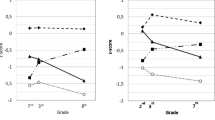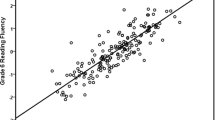Abstract
Children with isolated cleft of the lip and/or palate (iCL/P) are at increased risk for reading impairment. The purpose of this study was to evaluate the impact of early risk factors (hearing, speech, and early literacy) on reading performance compared to unaffected participants with average (uAR) and impaired (uIR) reading. Reading achievement and early literacy skills were evaluated across three groups (27 iCL/P, 32 uAR, and 33 uIR). All participants were males, ages 8–11 years old. Those with history of head trauma/injury or major medical/mental health conditions were excluded. Group differences in achievement and early literacy skills were evaluated with ANCOVAs. Participants with impaired reading achievement (at or below 25th Percentile) were identified. Medical record reviews for participates with iCL/P were conducted and audiology and speech ratings recorded. Correlations were calculated between achievement, early literacy, hearing, and speech. Participants with iCL/P had significantly elevated risk for reading impairment (37%); this risk differed by cleft type (0% iCL, 55% iCLP, and 60% iCP). Achievement for participants with iCP was similar to the uIR group. Early literacy risk resulted in lower achievement scores for both iCL/P and unaffected participants. History of inadequate hearing and speech did not significantly impact early literacy or achievement measures. There is a high risk of reading impairment for children with iCL/P—highest for those with iCLP and iCP. Early literacy predictors of reading outcome are similar for iCL/P and idiopathic dyslexia. Current screening and intervention methods are supported.

Similar content being viewed by others
References
Beitchman, J. H., & Young, A. R. (1997). Learning disorders with a special emphasis on reading disorders: a review of the past 10 years. Journal of the American Academy of Child and Adolescent Psychiatry, 36(8), 1020–1032. https://doi.org/10.1097/00004583-199708000-00009.
Chapman, K. L. (2011). The relationship between early reading skills and speech and language performance in young children with cleft lip and palate. The Cleft Palate-Craniofacial Journal, 48(3), 301–311. https://doi.org/10.1597/08-213.
Clausen, N. G., Pedersen, D. A., Pedersen, J. K., Moller, S. E., Grosen, D., Wehby, G. L., et al. (2016). Oral clefts and academic performance in adolescence: the impact of anesthesia-related neurotoxicity, timing of surgery, and type of oral clefts. Cleft Palate Craniofac J. https://doi.org/10.1597/15-185.
Collett, B. R., Leroux, B., & Speltz, M. L. (2010a). Language and early reading among children with orofacial clefts. The Cleft Palate-Craniofacial Journal, 47(3), 284–292. https://doi.org/10.1597/08-172.1.
Collett, B. R., Stott-Miller, M., Kapp-Simon, K. A., Cunningham, M. L., & Speltz, M. L. (2010b). Reading in children with orofacial clefts versus controls. Journal of Pediatric Psychology, 35(2), 199–208. https://doi.org/10.1093/jpepsy/jsp047.
Collett, B. R., Wehby, G. L., Barron, S., Romitti, P. A., Ansley, T. N., & Speltz, M. L. (2014). Academic achievement in children with oral clefts versus unaffected siblings. Journal of Pediatric Psychology, 39(7), 743–751. https://doi.org/10.1093/jpepsy/jsu049.
Conners, C. K. (2014). Conners continuous performance test, 3rd edition: Technical manual. North Tonawanda: Multi-Health Systems Inc..
Conrad, A. L., DeVolder, I., McCoy, T., Richman, L., & Nopoulos, P. (2014). Reading in subjects with an oral cleft: speech, hearing and neuropsychological skills. Neuropsychology, 28(3), 415–422. https://doi.org/10.1037/neu0000024.
Conrad, A. L., Richman, L. C., & Nopoulos, P. (2015). Reading achievement in boys with non-syndromic cleft palate only: relationship to neuropsychological skill and neurocircuitry. Developmental Neuropsychology, 40(7–8), 395–406. https://doi.org/10.1080/87565641.2016.1142991.
Daigneault, S., & Braun, C. M. (2002). Pure severe dyslexia after a perinatal focal lesion: evidence of a specific module for acquisition of reading. Journal of Developmental and Behavioral Pediatrics, 23(4), 256–265.
First Years. (2004). Retrieved from http://www.firstyears.org/lib/howtoread.htm
Fougner, V., Korvel-Hanquist, A., Koch, A., Dammeyer, J., Niclasen, J., Lous, J., & Homoe, P. (2017). Early childhood otitis media and later school performance - a prospective cohort study of associations. International Journal of Pediatric Otorhinolaryngology, 94, 87–94. https://doi.org/10.1016/j.ijporl.2017.01.016.
Galaburda, A. M., Fitch, R. H., LoTurco, J. L., & Rosen, G. (2011). Neurogenetic contribution to developmental reading disorders. In P. McCardle, B. Miller, J. Ren Lee, & O. J. L. Tzeng (Eds.), Dyslexia across languages: orthography and teh brain-gene-behavior link (pp. 226–238). Baltimore: Paul Brookes Publishing Co..
Gallagher, E. R., Collett, B. R., Barron, S., Romitti, P., Ansley, T., & Wehby, G. L. (2017). Laterality of oral clefts and academic achievement. Pediatrics, 139(2), e20162662. https://doi.org/10.1542/peds.2016-2662.
Goldsberry, G., O'Leary, D., Hichwa, R., & Nopoulos, P. (2006). Functional abnormalities in the neural circuitry of reading in men with nonsyndromic clefts of the lip or palate. Cleft Palate Craniofacial Journal, 43(6), 683–690.
Jocelyn, L. J., Penko, M. A., & Rode, H. L. (1996). Cognition, communication, and hearing in young children with cleft lip and palate and in control children: a longitudinal study. Pediatrics, 97(4), 529–534.
Lamb, M. M., Wilson, F. B., & Leeper Jr., H. A. (1972). A comparison of selected cleft palate children and their siblings on the variables of intelligence, hearing loss, and visual-perceptual-motor abilities. Cleft Palate Journal, 9, 218–228.
Mather, N., & Wendling, B. J. (2012). Essentials of dyslexia assessment and intervention. Hoboken: John Wiley & Sons, Inc..
Menghini, D., Finzi, A., Benassi, M., Bolzani, R., Facoetti, A., Giovagnoli, S., Ruffino, M., & Vicari, S. (2010). Different underlying neurocognitive deficits in developmental dyslexia: a comparative study. Neuropsychologia, 48(4), 863–872. https://doi.org/10.1016/j.neuropsychologia.2009.11.003.
Nicolielo-Carrilho, A. P., Crenitte, P. A. P., Lopes-Herrera, S. A., & Hage, S. R. V. (2018). Relationship between phonological working memory, metacognitive skills and reading comprehension in children with learning disabilities. Journal of Applied Oral Science, 26, e20170414. https://doi.org/10.1590/1678-7757-2017-0414.
Nopoulos, P., Berg, S., Canady, J., Richman, L., Van Demark, D., & Andreasen, N. C. (2000). Abnormal brain morphology in patients with isolated cleft lip, cleft palate, or both: a preliminary analysis. The Cleft palate-craniofacial journal : official publication of the American Cleft Palate-Craniofacial Association, 37(5), 441–446. https://doi.org/10.1597/1545-1569(2000)037<0441:ABMIPW>2.0.CO;2.
Nopoulos, P., Langbehn, D. R., Canady, J., Magnotta, V., & Richman, L. (2007). Abnormal brain structure in children with isolated clefts of the lip or palate. Archives of Pediatrics & Adolescent Medicine, 161(8), 753–758.
Nylund, A., Toivonen, L., Korpilahti, P., Kaljonen, A., Peltola, V., & Rautakoski, P. (2018). Recurrent respiratory tract infections or acute otitis media were not a risk factor for vocabulary development in children at 13 and 24 months of age. Acta paediatrica (Oslo, Norway : 1992). https://doi.org/10.1111/apa.14546.
Persson, M., Becker, M., Conrad, A. L., & Svensson, H. (2018). Female and male differences in academic achievement in individuals with cleft: A population-based register study. The Cleft Palate-Craniofacial Journal, 55(2), 196–203. https://doi.org/10.1177/1055665617726990.
Persson, M., Becker, M., & Svensson, H. (2012). Academic achievement in individuals with cleft: a population-based register study. The Cleft Palate-Craniofacial Journal, 49(2), 153–159. https://doi.org/10.1597/09-047.
Richman, L. C., Eliason, M. J., & Lindgren, S. D. (1988). Reading disability in children with clefts. The Cleft Palate Journal, 25(1), 21–25.
Richman, L. C., & Ryan, S. M. (2003). Do the reading disabilities of children with cleft fit into current models of developmental dyslexia? The Cleft Palate-Craniofacial Journal, 40(2), 154–157.
Schonweiler, R., Lisson, J. A., Schonweiler, B., Eckardt, A., Ptok, M., Trankmann, J., & Hausamen, J. E. (1999). A retrospective study of hearing, speech and language function in children with clefts following palatoplasty and veloplasty procedures at 18-24 months of age. International Journal of Pediatric Otorhinolaryngology, 50(3), 205–217.
Shaywitz, S. E., & Shaywitz, B. A. (2005). Dyslexia (specific reading disability). Biological Psychiatry, 57(11), 1301–1309. https://doi.org/10.1016/j.biopsych.2005.01.043.
Shaywitz, S. E., & Shaywitz, B. A. (2008). Paying attention to reading: The neurobiology of reading and dyslexia. Development and Psychopathology, 20(4), 1329–1349. https://doi.org/10.1017/S0954579408000631.
Shriver, A. S., Canady, J., Richman, L., Andreasen, N. C., & Nopoulos, P. (2006). Structure and function of the superior temporal plane in adult males with cleft lip and palate: pathologic enlargement with no relationship to childhood hearing deficits. Journal of Child Psychology and Psychiatry, 47(10), 994–1002.
Thanawirattananit, P., & Prathanee, B. (2013). Relationship of language development and hearing status in children with cleft lip and palate. Journal of the Medical Association of Thailand, 96(Suppl 4), S49–S54.
Wagner, R. K., Torgesen, J. K., & Rashotte, C. A. (1999). Comprehensive test of phonological processing. Austin: PRO-ED.
Wechsler. (2011). Wechsler abbreviated scale of intelligence - second edition manual. Bloomington: Pearson.
Wechsler. (2014). Wechsler intelligence scale for children (Fifth ed.). United States of America: PsychCorp.
Wehby, G. L., Collet, B., Barron, S., Romitti, P. A., Ansley, T. N., & Speltz, M. (2014). Academic achievement of children and adolescents with oral clefts. Pediatrics, 133(5), 785–792. https://doi.org/10.1542/peds.2013-3072.
Wehby, G. L., Collett, B. R., Barron, S., Romitti, P., & Ansley, T. (2015). Children with oral clefts are at greater risk for persistent low achievement in school than classmates. Archives of Disease in Childhood, 100(12), 1148–1154. https://doi.org/10.1136/archdischild-2015-308358.
Woodcock, R. W. (2011). Woodcock Reading mastery tests, third edition manual. Bloomington: Pearson.
Zumach, A., Gerrits, E., Chenault, M., & Anteunis, L. (2010). Long-term effects of early-life otitis media on language development. Journal of Speech, Language, and Hearing Research, 53(1), 34–43. https://doi.org/10.1044/1092-4388(2009/08-0250).
Acknowledgements
The author would like to acknowledge the contributions of Ian DeVolder, PhD and Emily Kuhlmann, BA in data collection as well as Scott Dailey, PhD in guidance with speech data collection and analysis. Thank-you to the chapter leaders at Decoding Dyslexia and the International Dyslexia Association who made recruitment so successful. Finally, thank-you to the families who participated in this study; their time and effort is greatly appreciated.
Funding
Research reported in this publication was supported by the National Institute of Dental and Craniofacial Research (award number DE024511) and the National Center for Advancing Translational Sciences of the National Institutes of Health (award number UL1TR002537).
Author information
Authors and Affiliations
Corresponding author
Rights and permissions
About this article
Cite this article
Conrad, A.L. Are predictors of reading impairment in isolated cleft similar to those in idiopathic dyslexia?. Ann. of Dyslexia 69, 153–165 (2019). https://doi.org/10.1007/s11881-018-00166-2
Received:
Accepted:
Published:
Issue Date:
DOI: https://doi.org/10.1007/s11881-018-00166-2




